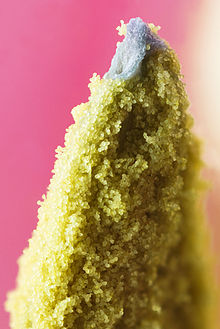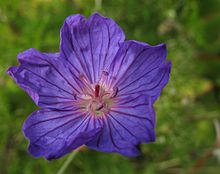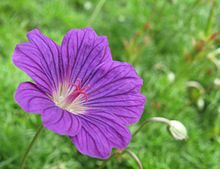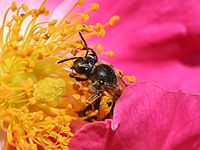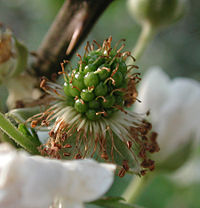- Pollination
-
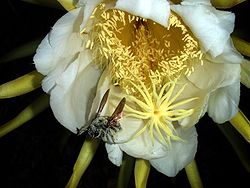 Carpenter bee with pollen collected from Night-blooming cereus
Carpenter bee with pollen collected from Night-blooming cereus
Pollination is the process by which pollen is transferred in plants, thereby enabling fertilisation and sexual reproduction. Pollen grains transport the male gametes (sperm) to where the by wind, depicted in Praesidium Sponsaliorum Plantarum by Carl Linnaeus, 1729.]] Abiotic pollination refers to situations where pollination is mediated without the various flower traits (and \ syndrome]]s.
There are roughly 200,000 varieties of animal pollinators in the wild, most of which are insects.[1] Entomophily, pollination by insects, often occurs on plants that have developed colored petals and a strong scent to attract insects such as, bees, wasps and occasionally ants (Hymenoptera), beetles (Coleoptera), moths and butterflies (Lepidoptera), and flies (Diptera). In zoophily, pollination is performed by vertebrates such as birds and bats, particularly, hummingbirds, sunbirds, [[\ fruit bats. Plants adapted to using bats or moths as pollinators typically have white petals and a strong scent, while plants that use birds as pollinators tend to develop red petals and rarely develop a scent (few birds rely on a sense of smell to find plant-based food).
Insect pollinators such as honeybees (Apis mellifera),[2] bumblebees (Bombus terrestris),[3][4] and butterflies (Thymelicus flavus) [5] have been observed to engage in flower constancy, which means they are more likely to transfer pollen to other conspecific plants.[6] This can be beneficial for the pollenisers, as flower constancy prevents the loss of pollen during interspecific flights and pollinators from clogging stigmas with pollen of other flower species.[7]
Contents
Mechanics
Pollination can be accomplished by cross-pollination or by self-pollination :
- Cross-pollination, also called allogamy occurs when pollen is delivered to a flower from a different plant. Plants adapted to outcross or cross-pollinate often have taller stamens than carpels or use other mechanisms to better ensure the spread of pollen to other plants' flowers.
 A European honey bee collects nectar, while pollen collects on its body.
A European honey bee collects nectar, while pollen collects on its body.
- Self-pollination occurs when pollen from one flower pollinates the same flower or other flowers of the same individual.[8] It is thought to have evolved under conditions when pollinators were not reliable vectors for pollen transport, and is most often seen in short-lived annual species and plants that colonize new locations.[9] Self pollination may include autogamy, where pollen moves to the female part of the same flower; or geitonogamy, when pollen is transferred to another flower on the same plant. Plants adapted to self-fertilize often have similar stamen and carpel lengths. Plants that can pollinate themselves and produce viable offspring are called self-fertile. Plants that cannot fertilize themselves are called self-sterile, a condition which mandates cross pollination for the production of offspring.
- Cleistogamy: is self-pollination that occurs before the flower opens. The pollen is released from the anther within the flower or the pollen on the anther grows a tube down the style to the ovules. It is a type of sexual breeding, in contrast to asexual systems such as apomixis. Some cleistogamous flowers never open, in contrast to chasmogamous flowers that open and are then pollinated. Cleistogamous flowers by necessity are self-compatible or self-fertile plants.[10] Many plants are self-incompatible, and these two conditions are end points on a continuum.
Pollination also requires consideration of pollenizers. The terms "pollinator" and "pollenizer" are often confused: a pollinator is the agent that moves the pollen, whether it be bees, flies, bats, moths, or birds; a pollenizer is the plant that serves as the pollen source for other plants. Some plants are self-fertile or self-compatible and can pollinate themselves (e.g., they act as their own pollenizer). Other plants have chemical or physical barriers to self-pollination.
In agriculture and horticulture pollination management, a good pollenizer is a plant that provides compatible, viable and plentiful pollen and blooms at the same time as the plant that is to be pollinated or has pollen that can be stored and used when needed to pollinate the desired flowers. Hybridization is effective pollination between flowers of different species, or between different breeding lines or populations. see also Heterosis.
Peaches are considered self-fertile because a commercial crop can be produced without cross-pollination, though cross-pollination usually gives a better crop. Apples are considered self-incompatible, because a commercial crop must be cross-pollinated. Many commercial fruit tree varieties are grafted clones, genetically identical. An orchard block of apples of one variety is genetically a single plant. Many growers now consider this a mistake. One means of correcting this mistake is to graft a limb of an appropriate pollenizer (generally a variety of crabapple) every six trees or so.[citation needed]
Pollen vectors
Pollen vectors are animals, usually insects, that transport pollen of plants when using the flowers for feeding, breeding or hiding. The pollen is found adhered to insect's body parts such as face, legs and mouthparts or to mammal's hairs, resulting or helping in the pollination of many plant species. An example are wasps, which can transport pollen and contribute for the pollination of several plant species, being potential or even efficient pollinators.[11]
Evolution of plant/pollinator interactions
Main article: Pollination syndromeThe first fossil record for abiotic pollination is from fern-like plants in the late Carboniferous period. Gymnosperms show evidence for biotic pollination as early as the Triassic period. Many fossilized pollen grains show characteristics similar to the biotically dispersed pollen today. Furthermore, the gut contents, wing structures, and mouthpart morphologies of fossilized beetles and flies suggest that they acted as early pollinators. The association between beetles and angiosperms during the early Cretaceous period led to parallel radiations of angiosperms and insects into the late Cretaceous. The evolution of nectaries in late Cretaceous flowers signals the beginning of the mutualism between hymenopterans and angiosperms.
In agriculture
Main article: List of crop plants pollinated by beesPollination management is a branch of agriculture that seeks to protect and enhance present pollinators and often involves the culture and addition of pollinators in monoculture situations, such as commercial fruit orchards. The largest managed pollination event in the world is in Californian almond orchards, where nearly half (about one million hives) of the US honey bees are trucked to the almond orchards each spring. New York's apple crop requires about 30,000 hives; Maine's blueberry crop uses about 50,000 hives each year.
Bees are also brought to commercial plantings of cucumbers, squash, melons, strawberries, and many other crops. Honey bees are not the only managed pollinators: a few other species of bees are also raised as pollinators. The alfalfa leafcutter bee is an important pollinator for alfalfa seed in western United States and Canada. Bumblebees are increasingly raised and used extensively for greenhouse tomatoes and other crops.
 Blueberries being pollinated by bumblebees. Bumblebee hives need to be bought each year as the queens must hibernate (unlike honey bees). They are used nonetheless as they offer advantages with certain fruits as blueberries (such as the fact that they are active even at colder outdoor ambient temperature).
Blueberries being pollinated by bumblebees. Bumblebee hives need to be bought each year as the queens must hibernate (unlike honey bees). They are used nonetheless as they offer advantages with certain fruits as blueberries (such as the fact that they are active even at colder outdoor ambient temperature).
The ecological and financial importance of natural pollination by insects to agricultural crops, improving their quality and quantity, becomes more and more appreciated and has given rise to new financial opportunities. The vicinity of a forest or wild grasslands with native pollinators near agricultural crops, such as apples, almonds or coffee can improve their yield by about 20%. The benefits of native pollinators may result in forest owners demanding payment for their contribution in the improved crop results - a simple example of the economic value of ecological services.
The American Institute of Biological Sciences reports that native insect pollination saves the United States agricultural economy nearly an estimated $3.1 billion annually through natural crop production;[12] pollination produces some $40 billion worth of products annually in the United States alone.[1]
Pollination of food crops has become an environmental issue, due to two trends. The trend to monoculture means that greater concentrations of pollinators are needed at bloom time than ever before, yet the area is forage poor or even deadly to bees for the rest of the season. The other trend is the decline of pollinator populations, due to pesticide misuse and overuse, new diseases and parasites of bees, clearcut logging, decline of beekeeping, suburban development, removal of hedges and other habitat from farms, and public concern about bees. Widespread aerial spraying for mosquitoes due to West Nile fears is causing an acceleration of the loss of pollinators.
The US solution to the pollinator shortage, so far, has been for commercial beekeepers to become pollination contractors and to migrate. Just as the combine harvesters follow the wheat harvest from Texas to Manitoba, beekeepers follow the bloom from south to north, to provide pollination for many different crops.
Environmental impacts
Loss of pollinators, also known as Pollinator decline (of which colony collapse disorder is perhaps the most well known) has been noticed in recent years.[13] Observed losses would have significant economic impacts. Possible explanations for pollinator decline include habitat destruction, pesticide, parasitism/diseases, and others.
See also
- Cheating (biology)
- Fruit tree pollination
- Hand pollination
- Self-pollination
- Domestication
- Pollination syndrome
- Canadian Pollination Initiative
- Hermann Müller (botanist)
- Paul Knuth (botanist)
References
- ^ a b US Forest Department: Pollinator Factsheet
- ^ Hill, P.S.M., P.H. Wells, and H. Wells. 1997. Spontaneous flower constancy and learning in honey bees as a function of colour. Animal Behavior, 54: 615-627.
- ^ Stout, J.C., J.A. Allen, and D. Goulson. 1998. The influence of relative plant density and floral morphological complexity on the behaviour of bumblebees. Oecologia, 117: 543-550.
- ^ Chittka, L., A. Gumbert, and J. Kunze. 1997. Foraging dynamics of bumble bees: correlates of movement within and between plant species. Behavioral Ecology, 8(3): 239-249.
- ^ Goulson, D., J. Ollerton and C. Sluman. 1997. Foraging strategies in the small skipper butterfly, Thymelicus flavus: when to switch? Animal Behavior, 53: 1009-1016.
- ^ Harder, L. D., N.M. Williams, C.Y. Jordan, and W.A. Nelson. "The effects of Floral design and display on pollinator economics and pollen dispersal". 297-317. Editors, L. Chittka and J.D. Thomson. Cognitive Ecology of Pollination: Animal Behavior and Floral Evolution. 2001. Cambridge University Press
- ^ Chittka, L., J.D. Thomson, and N.M. Waser. 1999. Flower constancy, insect psychology, and plant evolution. Naturwissenschaften, 86: 361-177.
- ^ Cronk, J. K.; Fennessy, M. Siobhan (2001). Wetland plants: biology and ecology. Boca Raton, Fla.: Lewis Publishers. p. 166. ISBN 1-56670-372-7.
- ^ Glover, Beverly J. (2007). Understanding flowers and flowering: an integrated approach. Oxford University Press. p. 127. ISBN 0198565968
- ^ Culley, Theresa M.; Klooster, Matthew R. (JAN-07). "The cleistogamous breeding system: a review of its frequency, evolution, and ecology in angiosperms". The Botanical Review. http://www.accessmylibrary.com/coms2/summary_0286-30779368_ITM
- ^ Sühs, R.B.; Somavilla, A.; Putzke, J.; Köhler, A. 2009. Pollen vector wasps (Hymenoptera, Vespidae) of Schinus terebinthifolius Raddi (Anacardiaceae), Santa Cruz do Sul, RS, Brazil. Brazilian Journal of Biosciences 7, n. 2, p. 138-143. Link: http://www.ufrgs.br/seerbio/ojs/index.php/rbb/article/view/1123
- ^ BioScience, April 2006, Vol. 56 No. 4, pp. 315-317
- ^ "What is the male, pollen-producing part of a plant called?". CNN. 2000-05-05. http://archives.cnn.com/2000/NATURE/05/05/pollinators.peril/. Retrieved 2010-05-22.
- Crepet WL, Friis EM, Nixon KC. 1991. Fossil evidence for the evolution of biotic pollination [and discussion]. Philosophical Transactions: Biological Sciences 333(1267) 187-195.
- Dafni, Amots; Kevan, Peter G.; and Husband, Brian C. (2005). Practical Pollination Biology. Enviroquest, Ltd. ISBN 978-0-9680123-0-7.
- Labandeira CC, Kvacek J, & Mostovski MB. 2007. Pollination drops, pollen and insect pollination of Mesozoic gymnosperms. Taxon 56(3) 663-695.
- Sihag, R.C. 1997.Pollination Biology: Basic and Applied Principles. Rajendra Scientific Publishers,Hisar, 210p.
External links
- New "Pollinator Garden Wheel" from the National Academies provides information on pollination and tips on building a pollinator-friendly garden.
- Insect Pollination Of Cultivated Crop Plants by S. E. McGregor USDA 1972 (needs updating but still valuable)
- The Pollination Home page
- Pollination in Hydroponics
- Pollination syndromes images at bioimages.vanderbilt.edu
Botany Subdisciplines of botany Ethnobotany · Paleobotany · Plant anatomy · Plant ecology · Plant evo-devo · Plant morphology · Plant physiology
Plants Plant parts Plant cells Plant reproduction Alternation of generations · Gametophyte · Plant sexuality · Pollen · Pollination · Seed · Spore · SporophytePlant taxonomy Glossaries Category · PortalCategories:- Symbiosis
- Pollination
- Horticulture and gardening
Wikimedia Foundation. 2010.

